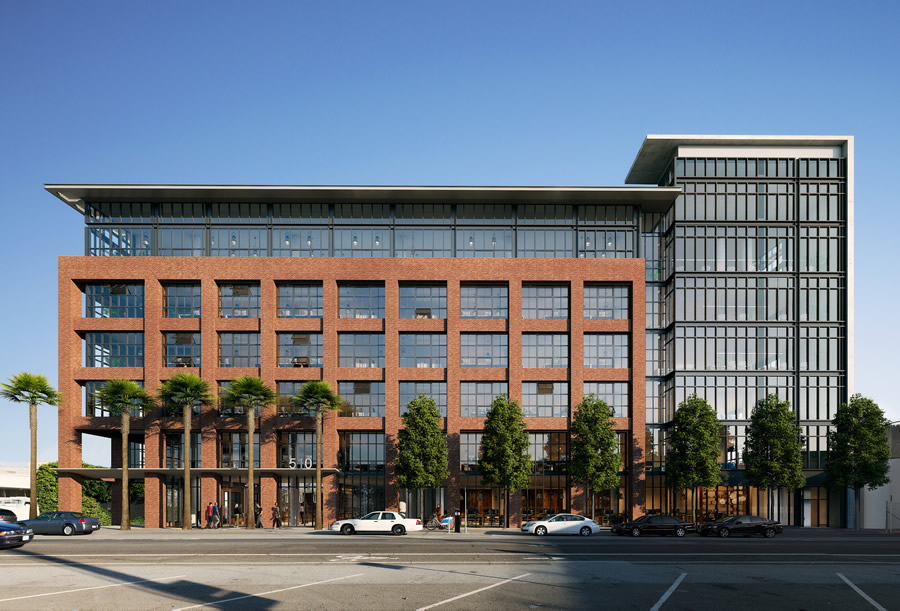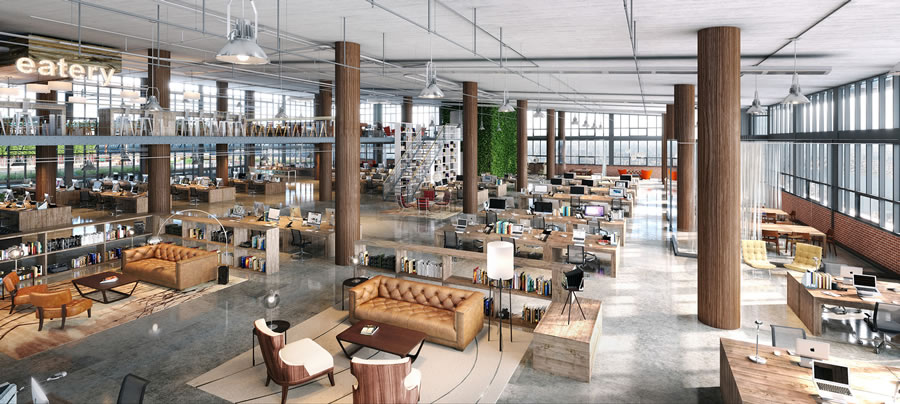
The paperwork for the building permits has been filed, the proposed development has been pre-leased to payments startup Stripe, and the public hearing which could clear the way for the 300,000-square-foot office building with open floor plans and a private “eatery” to rise at 510 Townsend Street has been scheduled for August 13.

Alexandria Real Estate will demolish the two vacant buildings at 510 and 520 Townsend to make way for the development which will rise up to 85-feet in height and abut the Sixth Street ramps for Interstate 280, ramps which could eventually be razed as well.
Assuming all goes as both sides plan, Stripe will move into the new building by the end of 2017.

Nice job disguising the workspace as a bar.
Is there anyway to control direct sunlight coming in from the big windows? Looks like there is nowhere to hide inside the open space. People might have to wear sunglasses at work and look at wash out computer screens.
Yes, there are plenty of ways to control direct sunlight: many options for interior shading including mechanized rolldown shades that raise and lower depending on the amount of sunlight entering.
This is a great project! Build it.
[Editor’s Note: The Future’s So Bright (Award Winning Federal Building Edition).]
Does anybody know if a sidewalk will get built in front of the building as part of this project?
It looks like it in the exterior rendering…
Yes, there will be new sidewalk in front of the building; there will also be a through-block covered pedestrian connection to Harriet Alley.
Thank goodness there’ll finally be sidewalks. Walking down this stretch of Townsend is horrible.
Jeebus they’re getting good at renderings these days. Also, noted is the lovely modest sun-air-joy-friendly height… so dull as dishwater it is, but these days who cares so long as its not a 40 story life-tomb condoplex? Endorsed here you read it 1st.
I spy a living wall on the interior? Nice!
You could fly a drone in that office.
I had a friend who worked in a nice office with high ceilings during the first dot com boom. They used to fly helicopters between desks with documents attached to them.
Fantastic. Approve it yesterday. Has anyone considered building taller to allow some upper floors of residential space for the workers below. This would help alleviate the housing crunch and help the company attract the best talent available who otherwise may be put off by having to be thrown into the SF housing market.
That’s what all the couches are for. No need to have an apartment above, just sleep at the office.
Saves time and money on commute too.
Can confirm. We can’t find coders. Their salary expectations are very high due to the high housing costs, and the housing costs go up due to the high salaries… 1999 is back.
Never enough BMR programmers when you need them. If you can’t afford SF pay rates, maybe move to someplace you can afford. Not like companies have some right to be in SF.
How many payment aps companies does the market need to serve the percentage of the population for which using a credit card or cash is such a chore?
Stripe’s entire business model is to make it trivially easy to integrated credit cards with your app. You’d have no idea if the app (or web site) you’re using uses Stripe to do payment processing. (Odds are pretty good if you’ve paid for something in an app — like Lyft, for example — you used Stripe without knowing you did.)
Instead of chasing the next great app, they’re building tools to make it easier for people to build apps. Kinda like how Levi’s got rich during the gold rush not by mining gold, but by selling equipment to the miners. They’re one of the smarter plays in the industry.
Bump to the very first comment. The tech industry has been a genius at making things appear cool – restaurant and bar in the office, fusbal tables, flying helicopters, cool furniture, free bus down and back to work. In reality it’s a very thin façade of coolness with the intention of keeping its staff at the office or working for as long as possible. And, generally, it works really, really well for some reason. I could think of nothing worse than having lunch (and/or breakfast, and diner…) at the office each day, for example..
You probably don’t like your job or co-workers then…
We should stop approving these private cafeterias. If the tech companies want to have an insular suburban culture they should stay/ move to the suburbs. It is terrible for our neighborhoods, killing neighborhood restaurants and cafes.
God forbid government would allow people to do what they want with their own space. We should also eliminate in unit laundry machines! People should be forced to patronize local Laundromats. The nerve of people designing space according to their own needs…
every large company has their own private cafeteria, whether located in the city or not. this has been going on for decades. not new and not tech.
My dad worked in the Bank of America building for years and had access to several cafeterias in the building. This is not something new to tech companies. And no, additional people in the neighborhoods is not “killing neighborhood restaurants and cafes”, but creating more of them.
I like this building’s architectural design very much. As someone who lives and works South of Market, I hope that larger scale developments like this will dedicate a meaningful portion of their ground floor space to retail tenants. The “New” San Francisco can coexist with the “Classic” San Francisco if it is designed with “neighborhood” in mind.
New developments can add value to a neighborhood by providing goods and services to tenants, locals, and visitors alike. Let’s revive our great city with new construction projects that make sound financial sense, that are visually stunning/inspiring, and that connect with the surrounding neighborhoods. This nicely designed building can be a win-win for its owners, its tenants, and the neighborhood. Profitable businesses + great design + great public access = great cities. The Pearl District in Portland did it, the Meatpacking district in Manhattan did it… so let’s continue doing it here in San Francisco.
Don’t we live here because the city has more to offer than just a paycheck? Let’s keep San Francisco interesting and beautiful, while simultaneously supporting the businesses that move here and support us. I like “Win-Win” opportunities 🙂
UPDATE: Future SoMa Tech HQ Approved To Rise